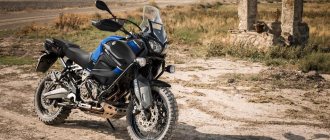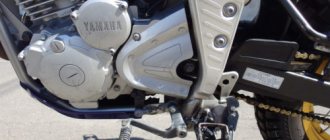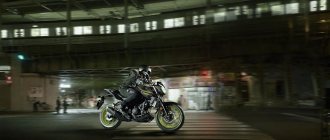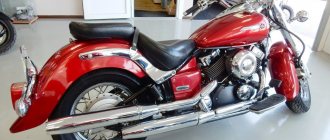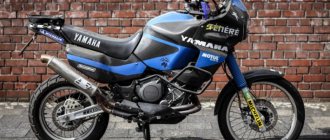- motorcycle model, Yamaha brand
The Yamaha V-max 1200 power cruiser model was introduced in 1985, appearing for the first time on the North American market. The concept of the motorcycle featured cruiser features, a powerful 4-cylinder V-twin engine, and the style and ergonomics of a drag bike. The V-MAX 1200 was one of the first production dragsters with a classic look, showing outstanding dynamic performance in 402 meter races.
The model was based on the engine from the Yamaha Venture Royale - a 4-cylinder V-shaped liquid-cooled unit with a volume of 1198 cm3 and producing up to 145 hp. power and up to 123 Nm of torque. The main feature of this engine is the presence of V-Boost technology, which was controlled by a servo drive, and at approximately 6000 rpm it opened additional throttle valves between the intake ports, thereby creating the effect of using large carburetors at higher speeds. The result of using this system is an increase in the amount of incoming fuel-air mixture at high speeds, which ultimately leads to an additional 10% increase in power. The V-Boost system was not installed on all Yamaha V-max 1200 motorcycles, but was mainly used on North American modifications.
Other features of the motorcycle include a simple layout with a steel duplex frame, classic suspension in the form of a conventional telescopic fork at the front and a double shock absorber at the rear, disc brakes, a 15-liter fuel tank, a 5-speed gearbox, a hydraulic clutch, a cardan drive and approximately 283 kg of curb weight. masses.
In 1987, the model underwent a slight restyling, receiving new rims and a reshaped saddle.
In 1993, the front suspension (more powerful fork), brake system (increased diameter of brake discs 282 → 298 mm, 4-piston calipers) and carburetors (Mikuni BDS34 → BDS35) underwent changes.
In 2003, the Yamaha V-max 1200 model received changes to comply with new environmental standards, reducing maximum power to 135 hp. for US model and up to 140 hp. for Canadian versions.
2007 was the last year of production of the model. This year's models are unified for 135 hp. power.
By 2009, a new model was introduced as a successor - the Yamaha V-MAX 1700.
Brief history of the model
1985 - start of production and sales. Model: Yamaha V-Max 1200 (North America). Factory designation: 1FK, 1GR, 1JH.
1986 - model available on the European market. Model: Yamaha V-Max 1200 (North America, Europe). Factory designation: 1UR, 1UT, 1VM, 2EN.
1987 - the model receives new rims. Model: Yamaha V-Max 1200 (Europe). Factory designation: 2LT.
1988 - no significant changes. Model: Yamaha V-Max 1200 (North America, Europe). Factory designation: 2EN, 2LT, 2WE, 2WF.
1989 - European versions receive new rims. Versions for different European countries can vary significantly in characteristics and configurations. The most powerful (145 hp) modifications are Canadian. Model: Yamaha V-Max 1200 (North America, Europe). Factory designation: 3JP1, 3JP2, 3JP3, 3LR1.
1990 - The model becomes officially available on the domestic Japanese market and receives a new ignition. Model: Yamaha V-Max 1200 (North America, Europe, Japan). Factory designation: 3JP4, 3JP5, 3LR2, 3UF1
1991 - due to the introduction of new noise regulations, the maximum power of European modifications is reduced to 95 hp. European versions are also equipped with a gearbox from Japanese modifications. Model: Yamaha V-Max 1200 (North America, Europe, Japan). Factory designation: 3JP7, 3JP8, 3LR3, 3LR4, 3UF2.
1992 - no significant changes. Model: Yamaha V-Max 1200 (North America, Europe). Factory designation: 3JP9, 3JPA, 3LR5, 3LR6, 3LR7.
1993 - restyling of the model. New front forks, front brakes and carburetors. Model: Yamaha V-Max 1200 (North America, Europe, Japan). Factory designation: 3JPB, 3JPC, 3JPD, 3LR8, 3LR9, 3UF3.
1994 - no significant changes. Model: Yamaha V-Max 1200 (North America). Factory designation: 3JPE, 3JPF, 3JPG.
1995 - The model changes the type of oil filter used. Model: Yamaha V-Max 1200 (North America). Factory designation: 3JPH, 3JPJ, 3JPK.
1996 - no significant changes. Model: Yamaha V-Max 1200 (North America, Europe, Japan). Factory designation: 3JPL, 3JPM, 3JPN, 3LRA, 3UF4.
1997 - no significant changes. Model: Yamaha V-Max 1200 (North America, Europe). Factory designation: 3JPR, 3JPS, 3JPT, 3LRB.
1998 - no significant changes. Model: Yamaha V-Max 1200 (North America, Japan). Factory designation: 3JPU, 3JPV, 3JPW, 3UF5.
1999 - no significant changes. Model: Yamaha V-Max 1200 (North America, Europe, Japan). Factory designation: 3JPX, 3JPY, 5GK1, 3LRC, 3UF6.
2000 - no significant changes. Model: Yamaha V-Max 1200 (North America). Factory designation: 5GK2, 5GK3, 5GK4.
2001 - the model receives fork protection and an updated exhaust system to meet new environmental requirements (Japanese versions). The model is also available on the South African market. Model: Yamaha V-Max 1200 (North America, Europe, South Africa). Factory designation: 3LRD, 5GK5, 5GK6, 5GK7, 5GK8.
2002 - no significant changes. Model: Yamaha V-Max 1200 (North America, South Africa). Factory designation: 5GK9, 5GKA, 5GKB, 5GKF.
2003 - update of environmental standards. European versions are no longer available. North American versions receive ignition changes and slightly reduce maximum power to 135 hp. (USA) and 140 hp. (Canada). These changes are consistent with Japan's 1998 emissions regulations. Model: Yamaha V-Max 1200 (North America, South Africa). Factory designation: 5GKC, 5GKD, 5GKE, 5GKG, 5GKH.
2004 - the model is equipped with an environmental system - a gasoline vapor trap. Model: Yamaha V-Max 1200 (North America, South Africa). Factory designation: 5GKL, 5GKM, 5GKN, 5GKP.
2005 - no significant changes. Model: Yamaha V-Max 1200 (North America, South Africa). Factory designation: 5GKR, 5GKS, 5GKT, 5GKU, 5GKV.
2006 - no significant changes. Model: Yamaha V-Max 1200 (North America, South Africa). Factory designation: 5GKW, 5GKX, 5GKY, 4C41, 4C42.
2007 is the last year of production. All versions produce 135 hp, regardless of whether they are Canadian or US. Model: Yamaha V-Max 1200 (North America). Factory designation: 4C43, 4C44, 4C45.
"YAMAHA REPAIR MANUAL."
…HOME…. YAMAHA Repair Manuals….
OPERATING INSTRUCTIONS FOR YAMAHA MOTORCYCLE EQUIPMENT Technical Information for YAMAHA MOTORCYCLE EQUIPMENT Catalogs of SPARE PARTS FOR YAMAHA MOTORCYCLE EQUIPMENT
(YZF-R7 1999 REPAIR MANUAL) (VMX1200 V-MAX 2001 REPAIR MANUAL) (FZ1 FAZER 2008 REPAIR MANUAL Russian) (XP500 TMAX 2012 REPAIR MANUAL) (MT09 REPAIR MANUAL 2014 Russian) (REPAIR MANUAL YZF R1M 2015) (2002 GRIZZLY660FWA REPAIR MANUAL) (2016 GRIZZLY700FWA REPAIR MANUAL) (1999 SRX700 REPAIR MANUAL) (VK540EF VIKING 540 20 REPAIR MANUAL 00) (2002 RX10H REPAIR MANUAL) (2007 PHAZER PZ50GT REPAIR MANUAL) ( REPAIR MANUAL APEX RX10PA 2011) (REPAIR MANUAL VK540 VIKING 540E 2013 Russian) (REPAIR MANUAL VK PRO VIKING PROFESSIONAL 2014 Russian) (REPAIR MANUAL2 VK10FG VIKING PROFESSIONAL 2 016 Russian) (REPAIR MANUAL SRV M-TX SR VIPER 2016 Russian language)
Please note the registration rules for YAMAHA ATVs and SNOWMOBILES! (Addresses and telephone numbers of GOSTEKHNADZOR by region of the Russian Federation) And also on the rules for registering your YAMAHA water equipment! (Addresses and telephone numbers of GIMS MOSCOW REGION)
You can go on a trip with a YAMAHA MOTOR TECHNIQUE. (We are going to SOCHI. Where is heaven on EARTH. Reading...)
We can help you choose a second-hand MOTORCYCLE. (We choose a motorcycle together with YOU. Read on...)
We will help you order original spare parts correctly! (How to order YAMAHA Spare Parts. Reading...)
You can also travel by water! (How to choose a propeller for a Yamaha motor. Reading...)
(Price for work)
Now we even have such a service as URGENT CALL TO THE CUSTOMER for repair and maintenance of MOTORCYCLES, SCOOTERS, ATVs, SNOWMOBILES AND OTHER YAMAHA MOTORCYCLES. First of all, these are Leningradskoe, Dmitrovskoe, Yaroslavskoe highway, Dolgoprudny, Dmitrov, Dubna, Kimry... Sometimes this is very necessary even at an EARLY or very LATE hour or on HOLIDAYS and WEEKENDS! Use it! We are located in Otradny Rimsky-Korsakov Street (NEAD), next to Altufevskoye Highway.
MOSCOW and SOCHI are waiting for YOUR calls at any time of the day or night.
Call now. 8916-681-6397 Alexander.
Or you can write by email and WE will be happy to answer YOU, YOU should have no questions left. This is our principle!
mailto
OUR FRIENDS:
BARBER-ROOM. Great Hairdressing Services for Great People. Any types of haircuts. www.barber-room.ru
HOME
All rights reserved. Reproduction of materials only with the permission of the content author! moto-m0t0.ru 2010-2013 © 8916-681-6397 [email protected]
Characteristics:
Technical characteristics of Yamaha V-max 1200:
| Model | Yamaha V-max 1200 |
| Motorcycle type | dragster (power cruiser) |
| Year of issue | 1985-2007 |
| Frame | steel duplex |
| engine's type | 4-cylinder, 4-stroke, V-shaped |
| Working volume | 1198 cm³ |
| Bore/Stroke | 76.0 x 66.0 mm |
| Compression ratio | 10.5:1 |
| Cooling | liquid |
| Number of valves per cylinder | DOHC, 4 valves per cylinder |
| Fuel supply system | Carburetor, 4x Mikuni BDS34 – V-MAX 1200 (1985-1992) Carburetor, 4x Mikuni BDS35 – V-MAX 1200 (1993+) |
| Ignition type | TCI |
| Maximum power | 145.0 hp (106.6 kW) at 9000 rpm - full power versions with V-Boost (for North America) 100 hp / 116 Nm – V-MAX 1200 (1986, Europe) 95.2 hp / 102 Nm – V-MAX 1200 (1991, Europe) 135 hp – V-MAX 1200 (2003, USA; all versions since 2007) 140 hp – V-MAX 1200 (2003, Canada) 97 hp / 111 Nm – V-MAX 1200 (Japan) |
| Maximum torque | 123.0 Nm (12.4 kg-m) at 7500 rpm - maximum torque for full power versions with V-Boost (North America) |
| Clutch | Multi-disc in oil bath, hydraulic drive |
| Transmission | 5-speed |
| type of drive | cardan |
| Front tire size | 110/90 V18 61V |
| Rear tire size | 150/90 VB15M/C 74V |
| Front brakes | 2 discs, 282 mm, 2-piston calipers – V-MAX 1200 (1985-1992) 2 discs, 298 mm, 4-piston calipers – V-MAX 1200 (1993+) |
| Rear brakes | 1 disc, 282 mm, 2-piston caliper |
| Front suspension | Telescopic fork, travel - 140 mm |
| Rear suspension | pendulum with two shock absorbers, stroke - 100 mm |
| Motorcycle length | 2300 mm |
| Motorcycle width | 795 mm |
| Motorcycle height | 1160 mm |
| Wheelbase | 1590 mm |
| Seat height | 765 mm |
| Minimum ground clearance (clearance) | 145 mm |
| Acceleration 0-100 km/h (0-60 mph) | 3.33 sec[1] |
| Maximum speed | 233 km/h[2] |
| Gas tank capacity | 15.0 l (including reserve - 3.0 l) |
| Motorcycle weight (curb) | ~283 kg |
Categories
- ATV (1)
- Yamaha (1)
- Banshee (1)
- Cars (55)
- Audi (4)
- 100 (1)
- 80 (1)
- A4 (1)
- BMW (3)
- 3 (1)
- 5 (1)
- 6 (1)
- 7 (1)
- Chery (1)
- Tiggo (1)
- Chevrolet (4)
- Aveo (1)
- Lacetti (1)
- Lanos (1)
- Niva (1)
- Citroen (1)
- C4 (1)
- Daewoo (1)
- Lanos (1)
- Fiat (1)
- Albea (1)
- Ford (2)
- C-MAX (1)
- Focus (2)
- Great Wall (1)
- Hover (1)
- Honda (2)
- HR-V (1)
- Hyundai (3)
- Santa Fe (1)
- Solaris (1)
- Tucson (1)
- KIA (2)
- Ceed (1)
- Rio (1)
- Mazda (1)
- Protege (1)
- Mercedes (1)
- E->
Flash Player 9 or higher is required to display the WP_Cumulus tag cloud. Free Russian templates for WordPress.All rights reserved © 2022 Auto Moto Manuals . Technical documentation, parts catalogs, user manuals for auto and motorcycle equipment | Thanks: wordpress themes
motorcycle strangers
Konstantin Medny
I finally got around to my old photos, back when the workshop didn’t exist. I decided to remember and tell it, maybe someone needs it, maybe not. A story for those who do not have the capabilities, but have the desire, for those who listen to everyone and do what they need to do, without forgetting to read the manual. It was evening, there was nothing. When I first saw a picture of this motorcycle in a motorcycle catalog for 1999 and read what they wrote about it, I was scared, to put it mildly. In those days, I dreamed of the 1100th Viraga and a leather jacket. Some time later I saw this motorcycle live at an exhibition. My state at that moment was incomprehensible to me, I really liked it, but I was still afraid of it, having not made up my mind, I hadn’t heard or read about it for almost a year (I was studying, working part-time, repairing my Ural and dreaming about the future) But here the day and hour came when, as they say, everything happened.
It all started as usual, early Monday morning. Having risen before dawn, I headed into the garage to delve into my Ural. From constantly digging in it, my teeth were already churning from frustration that it could barely drive. This finally got to me and I decided to earn money for a decent device that would not have to be climbed every 20 km. to tighten the valves, and constantly adjust the faulty ignition (I’m delicately keeping silent about everything else). The first time I drove the Max, after a night of digging with its overrunning clutch, the example had good mileage. The mots was my friend Gosha and after a night of digging in it, he allowed me to drive the Max. I drove the first 5 meters with an axle box. I thought that was it, my pants were irretrievably lost and I couldn’t wash them anymore (somehow I quickly accelerated to 140km), and after I shook out everything that was there from the diapers, I had to brake intensively (there are legends about the brakes of this motorcycle, but not all of this is true) I was impressed by this device and decided that I deserved better than what I had at the moment, it was time to change something in my life. This happened five years after the first trip on the Max. Many people told me that I don’t need it, that I will never buy it, that make your own Ural and drive it while it’s driving, I sent all this far, deep and for a long time!!!
I apologize for such a lyrical introduction. So August 17 came and my mother, along with others, arrived from Vladivostok by train, to my great regret, he arrived with more serious problems than was written in the information on the website of the well-known Sinus. But we can’t be overcome so easily and the work is in full swing. I disassembled it a couple of days before the screw and put everything into boxes. I disassembled the engine and was horrified by how much damage I had, 2 pistons, 2 connecting rods, 2 liners and almost no heat remained, everything that was there fit into a small 10x15 box. Well, okay, you can’t intimidate us like that! I had to get another engine from the Max that was twisted into a knot, it’s good that it turned out just in time (after all, I could have been stuck with this for a long time), and off we went. I dug through a bunch of Nets in search of a manual (I dug up 8 pieces), plus a lot of useful information, starting from photographs and ending with all sorts of tuning and baubles, this all helped a lot later.
First, I sandblasted and powder-coated the frame, the swingarm and all the little things, from the steering column risers to the footpegs. Then I started preparing for painting the stock parts (everything then had to be redone, since later I got a blank for the tail, which I later completely redid, this tail decided the further style of the device) It was already winter outside, and at home on the 14th floor work was in full swing. The other engine had to be rebuilt (I spent money on gaskets for the cylinder head, valve stem seals, a gasket for the head cover and I had to grind the valves, and at the same time I changed the spark plug caps along with the high-voltage wires), after looking at it I realized that the state of the shabby engine did not suit me. I painted it again, painted it myself at home (I actually had to sandblast it, and it was a big hemorrhoid). Having painted the engine and taken the frame with the pendulum from the service center, I began to assemble everything slowly. True, before that I read an advertisement in “hand to hand” about the fork from the first “Erka” in 2002 and decided that I had to buy it, it’s expensive, but it was worth it. The fork pulled along the traverses, which I successfully bought from the guys from Hyperbike, where, by the way, they cut into me and scalded my hub because I decided to go ahead and change the bike to 17 wheels. I bought the wheels from Kawasaki ZZR1100, along with brake discs, not expensive - I was lucky.
While they were cooking all this for me, I managed to trim the seat by 6 cm, make a base for the back one and cover it with leather, I sewed it myself, at a friend’s house because... I didn’t have my own typewriter at hand. At the same time, I made a drawing of an amplifier for the frame, which I spied on a US website, and instead of silent blocks, I machined aluminum bushings, now there is no extra flexibility of the frame, everything is rigid and strong. The rear shock absorbers from Yamaha XJR1200 are fully adjustable, just what the doctor ordered (successfully replaced with original Max wheels), although I made new heels on them. The extensions on the fork had to be tricked out, what I pulled out from the net did not inspire me with confidence. For a long time, the guys at the factory couldn’t understand what it was for and how it worked, but they made it conscientiously from D16T aluminum, and they also made according to my drawings: all the fasteners for HELLA car headlights,
the original one no longer fit with the general concept, the fasteners for the brake calipers (6-piston, just a plague), the fasteners for the fairing, the donor of which was a wing from the CBR, and the fasteners for the lower spoiler were made from an aluminum shovel, so the front wheel axle was remade , the speedometer drive had to be machined for the new axle. While it was all being invented, sharpened, milled and adjusted. I ordered turn signals, handles, extensions for the frame, arches, exhaust and of course red reflectors for the radiator caps from the catalog, bought mirrors and a steering wheel in a store, but the steering wheel had to be cut, it was too big. All this was a relatively short wait, if you count my ability to make money as a unit of time, it took me 4 months, maybe more. Winter is long over, spring has come, the opening of the season has passed, and I haven’t even started the engine yet, they looked at me like I was an eccentric who likes to assemble rather than drive, but I didn’t want to drive an unfinished machine, so I resisted and postponed all orders for work and started finalizing everything that I didn’t finish. I installed reinforced brake hoses not only on the front, but also on the rear brake and clutch, painted the grille on the radiator and sidewalls, successfully bought a carbon front fender from the first Erka in 2005, but I actually had to adjust the fasteners on the fork heels to fit it. Finally they made my rear wheel and I took them (the front one too) to powder for painting, immediately after painting I put them on new tires (Pirelli Diablo 120x70x17, 180x55x17) And then the long-awaited summer came, it seems everything was ready, but then it came to me put a lower spoiler in my head, I made it for about two weeks, at first I made it out of fiberglass, but then I bought ABC plastic and with the help of a hairdryer and such and such a mother I bent what happened, a very cool spoiler, cheaper by 100 bucks than a custom one. I started it and I also rebuilt the carburetors at home (BIG HUMAN THANKS to Auntie Inessa Vladimirovna, if not she, then I will have to spend the winter in a cold garage without a stove and light.) While all this was happening, I solved the problem with the light by installing Japanese xenon, the blocks were successfully placed in the tail of the motorcycle . Everything was fine with the tail of the vehicle, but with the fender liner and fasteners for the number of ambush, I got out of this situation simply - I made the fender liner from the original rear wing, and to match the number I bent a plastic platform to which the turn signals are now attached and attached it to an aluminum profile, bending it it according to the shape of the wing. It's time to paint. There were 8 projects for this matter, but as always, all the right thoughts come at the very last moment, I painted it in a sports-combat classic livery with a new (my) logo and brand name. I didn’t dare trust the painting to anyone and did everything myself, fortunately I have experience in this. I painted everything with expensive paint and didn’t waste my time with anything less.
And then the day and hour came when we (me and my friend Dimych) pulled him out into the street. It’s good that there is a freight elevator, but the additional doors didn’t open; they lifted the front of the car up and pushed it in there. How they pulled it out into the street, how a lot of people gathered and everyone asked about its cost (how this question bothered me), how I immediately sat down and went to run it in and didn’t notice that I got to my friends in Nizhny Novgorod, I won’t tell you this is a separate story.
I’m very pleased with how the MAX turned out, it stands rooted to the spot on the road, it takes turns in one go, it doesn’t twist or wobble at all, it’s a special thrill to take long turns at good speed, the tires stick to the asphalt like chewing gum. I’m not just pleased with the brakes, but very pleased, from 160 km to 0 km it slows down in a matter of seconds, and it’s not for nothing that the Hayabusa has 6-piston calipers, great. The reinforced rear pendulum, together with new shock absorbers and the 17th wheel, does not twist when turning (I did not expect such a noticeable effect). Having installed new traverses on the fork, I changed the distance between the wheel axles instead of the stock 1590, so the 1570 steers like a bicycle, and for such a large motorcycle this is simply an achievement and it turned out to be 20 - 25 kilos lighter than the standard. Definitely didn’t do anything to the engine, there’s plenty of stupidity already, there’s still some left, but we’ll see.
PS
Guys, if you want to do something, then you need to take it and do it, without listening to any “good” advice from friends and acquaintances who themselves do not know how to work with their hands and heads, but only advise - fuck them all. In this life you are alone and no one will help you do what you want.
Specifications:
Model: Yamaha V-MAX 1200 Engine: Stock Frame: Stock Length: 2100mm Wheelbase: 1570mm Dry weight: about 240 kg Fork: Yamaha R1 Rear shock absorbers: Yamaha XJR1200 Wheels: 17-piece wheels from Kawasaki ZZR1100 with welded-in hub from V-MAX Front tire: 120x70x17 Pirelli Diablo Rear tire: 180x55x17 Pirelli Diablo Brakes: 6-piston from GSX-1300R, 310 discs. Rear standard, 298th disc. Release: 4 in 4 COBRA. Headlights: HELLA automotive optics, plus xenon. Body kit: Rear fender + fasteners for it, front spoiler + fasteners for it, front fairing + fasteners for it, all fasteners for the headlight, amplifier for the frame, aluminum bushings instead of silent blocks, racks for the fork, fasteners according to the number, adapters for brake calipers, reinforced hoses, pilot and passenger seats - All with my own hands and according to my drawings. Stretch bars, arches, handles, levers, exhaust, mirrors, key fob - everything is from a catalogue. Painting: Painting and design are mine. The frame, handlebar pendulum, remote controls, rear brake bracket, wheels, footrests, and all small fasteners are powder coated. Construction time: One year and 5 days. Construction budget: Spent: a lot of mental strength, desire, skill and health. You can’t measure this in money (it’s too much) People who know will understand! Year of construction: 2005
Winter came, long and sticky like honey, but there was no time to be sad and wait for spring with a bottle of your favorite time. The spare parts that I ordered in the summer arrived and the work flowed like a mountain river during the rainy season.
First of all, I made a new card and some parts of the pendulum from my old 5.00-17 wheel I made 8.5-18 by welding it into a sports rim from a Porsche 911, which I got for a bottle of pepper. While the wheel was being made, I enlarged and boiled the stock tank, it turned out to be 27 liters. From the outside it is not noticeable at all.
Having seen on one of the French sites how local Drag Racers are improving their air intake, I decided to follow their path and installed a Charger with a double filter element from K&N
I didn’t calm down on this and made the running boards in the image and likeness of Mekov’s ones. Since I didn’t have 26 thousand for them, and to be honest, the toad was pressing.
I thought that was it, but then the Nitrous Set finally arrived and off we go. Disassembled, installed, adjusted, configured. I bought and installed DinoJet 7, it took me a long time to study, translate, correspond with the Americans and ask them for advice, because... Having visited 18 services, no one could intelligibly help me or install it.
But then summer came and I, happy and tired, realized that this was not all. But it was just beginning! Having saved up some money and attracted sponsors, I went to Finland for the Drag Battle and, wearing a belt and eating snacks, bought a mechanical compressor of the Roots type, almost new from some Merina. After reading about its characteristics, make drive pulleys for both the knee and the compressor shaft (the problem turned out to be terrible and long), I had to abandon the stock carbs and I bought 2 NSR-45s, which were more than suitable in terms of performance and began to install and tune.
Unfortunately, you can’t trust domestic sponsors, and finding myself without money, I wasn’t able to go anywhere, but it’s all water compared to what happened.
2.4-up to a hundred Almost 280-bald (with nitrous of course) and 196 without nitrous Terribly powerful and this completely frightening motor. The measurements were carried out at the stand; unfortunately, I didn’t drive it live that much (This is a story about the first time and shitting my pants) But I need to write about this separately.
Source

